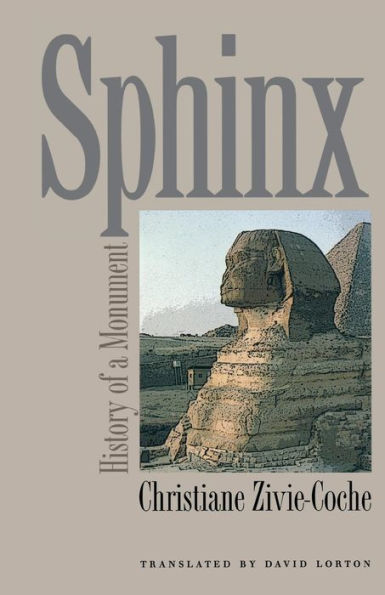5
1

Sphinx: History of a Monument
144
by Christiane Zivie-Coche, David Lorton (Translator)
Christiane Zivie-Coche

Sphinx: History of a Monument
144
by Christiane Zivie-Coche, David Lorton (Translator)
Christiane Zivie-Coche
Paperback
$30.95
-
PICK UP IN STORECheck Availability at Nearby Stores
Available within 2 business hours
Related collections and offers
30.95
In Stock
Overview
"Sphinxes are legion in Egypt—what is so special about this one?... We shall take a stroll around the monument itself, scrutinizing its special features and analyzing the changes it experienced throughout its history. The evidence linked to the statue will enable us to trace its evolution... down to the worship it received in the first centuries of our own era, when Egyptians, Greeks, and Romans mingled together in devotion to this colossus, illustrious witness to a past that was already more than two millennia old."—from the IntroductionThe Great Sphinx of Giza is one of the few monuments from ancient Egypt familiar to nearly everyone. In a land where the colossal is part of the landscape, it still stands out, the largest known statue in Egypt. Originally constructed as the image of King Chephren, builder of the second of the Great Pyramids, the Sphinx later acquired new fame in the guise of the sun god Harmakhis. Major construction efforts in the New Kingdom and Roman Period transformed the monument and its environs into an impressive place of pilgrimage, visited until the end of pagan antiquity.Christiane Zivie-Coche, a distinguished Egyptologist, surveys the long history of the Great Sphinx and discusses its original appearance, its functions and religious significance, its relation to the many other Egyptian sphinxes, and the various discoveries connected with it. From votive objects deposited by the faithful and inscriptions that testify to details of worship, she reconstructs the cult of Harmakhis (in Egyptian, Har-em-akhet, or "Horus-in-the-horizon"), which arose around the monument in the second millennium. "We are faced," she writes, "with a religious phenomenon that is entirely original, though not unique: a theological reinterpretation turned an existing statue into the image of the god who had been invented on its basis."The coming of Christianity ended the Great Sphinx's religious role. The ever-present sand buried it, thus sparing it the fate that overtook the nearby pyramids, which were stripped of their stone by medieval builders. The monument remained untouched, covered by its desert blanket, until the first excavations. Zivie-Coche details the archaeological activity aimed at clearing the Sphinx and, later, at preserving it from the corrosive effects of a rising water table.

Product Details
| ISBN-13: | 9780801489549 |
|---|---|
| Publisher: | Cornell University Press |
| Publication date: | 09/02/2004 |
| Pages: | 144 |
| Product dimensions: | 5.50(w) x 8.50(h) x 0.44(d) |
| Age Range: | 18 Years |
About the Author
Christiane Zivie-Coche is Professor at L'Ecole Pratique des Hautes Etudes. She is coauthor with Françoise Dunand of Gods and Men in Egypt: 3000 BCE to 395 CE (also from Cornell) and the author or editor of more than a half dozen books in French. David Lorton, an Egyptologist, lives in Baltimore, Maryland.
Table of Contents
| Acknowledgments | ix | |
| Translator's Note | xi | |
| Chronology | xiii | |
| Introduction | 1 | |
| 1 | Sphinx-Sphinxes | 4 |
| The Hybrid Nature of the Sphinx | ||
| The Word Sphinx | ||
| 2 | The Modern History of the Sphinx | 13 |
| From Antiquity to the Twentieth Century | ||
| The Era of Excavations | ||
| The Great Excavations of the Twentieth Century | ||
| 3 | Description and History of the Sphinx | 23 |
| 4 | The Old Kingdom: The Sphinx as Part of the Chephren Funerary Complex | 36 |
| 5 | The Transformations of the New Kingdom | 41 |
| Memphis in the New Kingdom | ||
| The Royal Undertakings | ||
| Personal Devotion | ||
| The Invention of a God: The Role and Cult of Harmakhis | ||
| Harmakhis and the Other Gods of Giza | ||
| 6 | The New Focus of the First Millennium | 78 |
| The Memphite Context | ||
| The Trace of Sovereigns | ||
| The Stela of the Daughter of Cheops | ||
| The Chapel of Harbes and the Priesthoods of Harmakhis | ||
| Harmakhis and His Temenos during the Last Dynasties | ||
| 7 | The Greco-Roman Period | 98 |
| Bibliography | 111 | |
| Index | 117 |
What People are Saying About This
Elizabeth Crowley
If you're on the way to Egypt or you've always wanted to go... then you might want to know more about the Sphinx, or the Great Sphinx of Giza, as it is formally known.... In Sphinx: History of a Monument, Christiane Zivie-Coche takes us through the life and times of this landmark—nearly 65 feet tall, from ground to top of headdress, and 238 feet long, from forepaws to lion's tail.
From the B&N Reads Blog
Page 1 of
